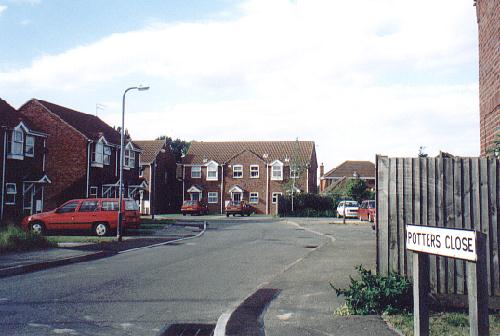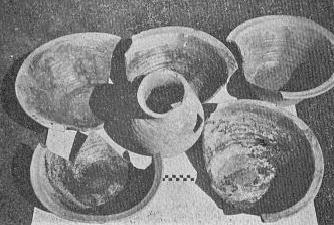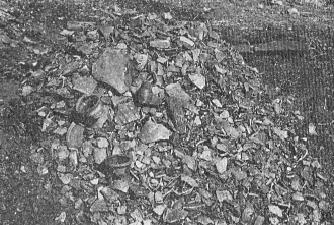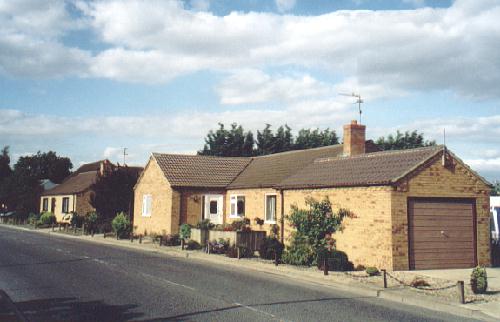|
The
pottery industry in Bourne
Fragments of pottery
that are often unearthed in the eastern district of the town are signs of a long lost industry in Bourne. Documentary evidence about this activity is scarce but a mention of Potter Street is made as early as 1380 in an inventory of the estate of Lady Blanche Wake and recent excavations have indicated that the centre of this industry in the Middle Ages was certainly in the area north of Eastgate, a street which lies parallel to the Bourne Eau and runs out towards the fen, and on each side of what is now Cherryholt
Road.
Specimens of mediaeval pottery have been found in several places, in outlying fields, on the site of the Abbey church and during the building of Woolworth's store in North Street. But by far the greatest quantity of these remains have been discovered in and around Eastgate where mediaeval kilns, clay pits and workshops existed and all the other structures associated with the production of pottery. A considerable amount was also unearthed when the gas works were being enlarged in 1895-97, mainly bung-holed pitchers, and a kiln or group of kilns almost certainly existed at the east end of Eastgate where a remarkable abundance of material has come to light. Cooking pot sherds were also unearthed in 1967 when the electricity board was excavating a trench close to Cherryholt
Road and further trenches revealed more sherds which were identified as "wasters", pots thrown away because of accidents in manufacture, indicating the presence of a kiln. It then became apparent that the garden in which the first trench had been dug was lying on a great seam of earthenware several feet thick.
Two bungalows in Cherryholt Road were found to be also resting on this seam, about a foot underneath the ground surface and it has been surmised that this large amount of pottery represented the waster heap of a kiln dating from the 15th century. The fragments of cooking pots, jugs and pancheons that were found were often of a particularly coarse nature, probably used by farmers and as common domestic utensils, but quite unlike any other pottery in the area. There were also some smooth and calcite-gritted wares and some sherds were decorated with thumbing, applied vertical strips, nail imprints and glaze. Further pottery finds have been made to the east of Cherryholt
Road which points to the probable existence of a series of pottery kilns and though much research still needs to be done concerning the precise date of this local industry, it is likely that it played an important part in the development of Bourne in past centuries.

|
A
new residential estate
in Eastgate
called
Potters
Close
to
mark
the
thriving industry
of
past
times. |
Mediaeval Eastgate had a mixture of light industry, cottages and, in all probability, an alehouse, and the occupation of many people who lived hereabouts was undoubtedly making pots for the townspeople. An important archaeological dig was carried out in the spring of 1973 by the late Nigel Kerr, a local architect and amateur archaeologist with an interest in the Eastgate potteries that went back to his boyhood, and with the assistance of a group of like-minded volunteers, their excavations provided further information of the potteries that existed on this site. Their task was particularly urgent because of the imminent widening of Cherryholt
Road to take heavy traffic for the expanding industrial estate around Tunnel Bank. Fortunately, excavations were completed within the time scale provided and Mr Kerr presented his findings at a lecture given at the Red Hall some weeks later.
The work had confirmed that Eastgate is built on a very good seam of pottery clay and the whole site at the lower end of the area was riddled with pits from which clay had been taken in days gone by. The 1973 investigation was concentrated on one of the numerous potteries that had existed in the Eastgate area. On the north-eastern corner of the junction of Cherryholt
Road stood a potter's house in earlier times. The cottage occupying that site had been inhabited until about 1940 when it was demolished and was found to have been of 18th century origin. But the mediaeval floor of an earlier building was uncovered showing that this had in fact been the home of the potter and this floor was made of baked pottery clay. Next to the house, moving northwards along Cherryholt
Road, there had been a store and beyond that the potter's workshop while nearby was a pit for clay storage and a waster heap from which many fragments had been recovered.
Finally, there was the kiln, which would have been a domed structure with three separate openings each containing a fire. To the north of it was a boundary ditch. These then were the premises of a local craftsman, or more probably of a succession of craftsmen over many years, for under the 16th century yard, a series of earlier hearths were found and it seems likely that there was activity on the site as early as the 13th or 14th centuries. Indeed, a flat-rimmed pot found there did suggest work dating back to that earlier period, while a quick investigation of the opposite corner of the road junction also showed traces of kilns of an earlier date than the one described.

Some
of the 16th century pots unearthed |

Pottery
sherds broken in manufacture |
The 1973 dig was arranged after Mr Kerr noticed that broken pottery was being dug-up during the construction of an electricity sub station in Cherryholt
Road. Observation of building work and ploughing in the area, as well as documentary research and excavation, built up a clearer picture of the industry and old documents even revealed the names of some of the Bourne potters who were working during the 16th and 17th centuries, and from the excavated evidence, it was known where some of them lived and worked.
The road-widening scheme in Cherryholt Road would certainly affect one of the suspected potting sites and so it was decided that it should be excavated and recorded in advance of the road improvements. Careful observation of the site suggested the existence of a pottery kiln at one end with the possibility of a house on the Eastgate frontage. Accordingly, the archaeologists set to work with a mechanical excavator to remove the modern garden soil in order to have the maximum time in which to investigate the older levels. Predictions of the site's nature turned out to be fully justified and a full-scale excavation was arranged. All the workers on the site were amateurs, and many people in the Bourne area helped in various ways. A succession of visitors inspected the site during the excavations and their contributions helped to finance the work and the project was also funded by grants from the Department of the Environment, the Lincolnshire Association and the former Bourne Urban District Council.
The story of these potteries began in the 15th century when large pits were dug to obtain clay for making pots. They were backfilled with vast quantities of broken pots, either wasters or rejects from kilns elsewhere. After this phase of activity, a series of buildings were erected on the Eastgate frontage, the most important of which belonged to the 16th century. At that time the land was owned by a potter who carried out his business there and also included a house, a possible shop, a workshop, a clay store and a kiln. The site therefore provides one of the most complete examples of a late mediaeval pottery production unit known in Britain. The ceramics produced were of high quality that were in demand all over South Lincolnshire while the quantity of broken pieces, together with the absence of any indications of agricultural activity, suggest that potting was the permanent occupation of the people living there, rather than just being a seasonal activity.
The pottery kiln itself was of a relatively sophisticated type with three flues designed to funnel hot air into the firing chamber where the pots stood. The structure was made of clay reinforced with withies, impressions of which were found in the walls. A new clay floor had been laid in the kiln, but had never been used. The workshop had much potting clay trodden into the floor, and the small pit at the north end was still half-filled with cleaned clay. Fragments of two stone mortars used for grinding-up glazing materials were found in the workshop, as well as an iron tool used for shaping the pot rims.
Apart from the industrial evidence, some indications of the daily lives of the people were discovered. The presence of cockle and mussel shells in the rubbish pits, as well as pig, cow and sheep bones, provided information on their diet. No doubt the seafood formed part of a return cargo from Boston or Spalding, perhaps in exchange for some of their own pots. The floors of the house which had been made up with successive layers of trampled clay told a grim story of rheumatics and winter chills as they strove to keep out the dampness of the fen. Finds of small clay "whorls", used for counterbalancing spindles, together with a bronze thimble, suggest the activities of womenfolk. The large number of bung-hole jars, suitable for holding beer or cider which were made on the site, appear to be an indication of the habits of those who lived there, especially the men. We know from elsewhere that potters tended to be somewhat unruly and they often appear in medieval court records as drunkards or other miscreants.
On this site, the diggers had a good opportunity to observe one part of the local pottery industry. It is highly probable that the whole production was arranged in a series of such small units. Each potter and his family, together with such men as he could afford to pay, dug the clay, cleaned it, threw the pots on the wheel, fired them in the kiln, transported them and finally sold them in the local markets. But the story of the industry from this period is still incomplete and the beginnings of pottery production are also shrouded in mystery except for the Romano-British kiln unearthed on the grammar school site in South Street.
In the Middle Ages, pottery appears to have been made in the town at least since the 14th century and production seems to have petered out at some time in the 17th century. The end of the industry is as uncertain as the beginning. There is some documentary evidence relating to this problem and occurs in the form of a note in the parish register: "On the 25th of May 1637, a fearful fire raged in Eastgate". There is also a footnote that reads: "The fire destroyed the greater part of Potter Street and did much damage to East Street (or Eastgate). The cause . . . happened through carelessness at the potteries, which were destroyed with the street and never after rebuilt."
This then, appears to mark the end of our pottery industry. Rather like the baker in Pudding Lane who started the Great Fire of London, the potters apparently allowed their fire to get out of control and it put an end to their activities. It is interesting in this connection to note the half-empty clay pit and the unused kiln floor on the site. Was this activity halted by the fire? Certainly the workshop, which was at the Eastgate end of the plot, did show some evidence of destruction by fire. The mud from its collapsed walls had been partly burnt before they fell. Perhaps this event did mark the end of pottery making on the site. A date of 1637 is quite compatible with the limited dating evidence from the excavation although it most likely continued on a sporadic basis because in 1699, a potter called William Astin contracted a deal with a Spalding merchant. If the town's pottery industry did indeed finish in 1637, then it is a very long time for a man to be called potter if he had not actually worked at the trade for over 60 years. Astin's description suggests that the industry may have gone on later than 1637, so we must keep an open mind on the business until we have further evidence.
The Bourne industry flourished during the later Middle Ages, at a time when most of the pottery used in England was made on a small scale in local production centres. In Lincolnshire, as elsewhere, many small towns and villages had potters working with varying degrees of competence and success. This fact is of great value to the archaeologist, as it enables him to trace local trading patterns in the past and with luck, to date the sites he excavates. Yet our knowledge of this industry in Lincolnshire is still very limited. On many mediaeval sites in the county, pottery is found which must have been made locally, but we do not know where. Just as the kilns at Bourne were discovered accidentally during building operations, so others may come to light in the future.
Roman pottery
Discoveries of Roman pottery in the town are well documented because this was the best known of the industries of Roman Britain, and although important centres such as Castor, near Peterborough, and the New Forest in Hampshire, produced quite different wares on a large scale, it is probable that a host of local potters were at work supplying the market.
Remains
from this period have been found along the Car Dyke and in August 1896, Roman
pottery was found during construction work to enlarge the gas works plant in
Eastgate on land that had been recently purchased for that purpose. Five vases
of thin but hard and smooth-worked pottery were discovered embedded in the clay,
6ft. 8in. from the surface. The vases were inverted but appeared to have been
carefully placed in position. They were all 14in. in height, 7in. in diameter at the top and base,
the widest circumference being 3ft. Four of them had a
pair of ear-shaped handles. Three of the vases were perfect and the other two
had manufacturing defects. The Stamford Mercury reported: "It is
worthy of note, as illustrating the value of ancient street names, that formerly
Eastgate, where these vases were found, was called Potter's Gate, and old
records state that large Roman pottery works existed here. The present discovery
would appear to confirm this tradition, additional weight being lent by the fact
that a large heap of broken pottery is being unearthed in the same
excavation."
Further
discoveries were made in 1905 when a builder unearthed a kiln near the school in Abbey Road. The heaps of blue clay on the site were not of local Oxford clay, and it has been suggested that they may have been brought along the Car Dyke itself. Another kiln of the period was discovered in 1959 during excavations at the grammar school. Fragments of five earthenware jars were taken from the firing chamber of this kiln and it has been possible to reconstruct these vessels. Various other pieces of pottery were found as well as charcoal that would be used for heating the kiln. Two objects, thought to have been candlesticks, were retrieved from the entrance to the firing chamber. There was also a metal article, not quite complete, which has been classified as some kind of spoon.
During further excavations in 1964, a small earthenware bowl was found not far away on the same site and removed from the soil intact. Thus it is clear that Bourne at that time was being supplied with at least some of its pottery and earthenware from local manufacturers. On the other hand, the discovery in the grammar school excavations of some pieces of reddish-brown Samian ware shows that pottery from abroad, probably from Gaul or Belgium,
was reaching this area, as indeed it reached all parts of Britain. If Bourne had yielded none of the ubiquitous Samian ware, it would have been unique as a Roman site.
In the autumn of 1970, while excavations were being carried out at the grammar school for a swimming pool, numerous fragments were found including a mortarium or mixing bowl of circa 80-110 A D, part of a pie dish, a cooking pot and other pieces from the latter half of the 2nd century, some very coarse fabric native ware imitating Roman forms, some Nene Valley coloured coated ware, probably 180-320 A D,
2nd century Samian ware made at Lezoux in Central Gaul with a British copy of the same, and some large storage vessels. These, together with the kiln and other finds of 1959 on the same site, constitute the most significant discovery of Roman remains. Further signs of Roman settlement are still coming to light. A sherd of grey ware, coarse tessarae of tile and stone, and a roofing tile were discovered in the 1970s whilst a more unusual find by a local amateur archaeologist has been a glass tear bottle in the garden of a house in Mill Drove, about 500 yards west of the Car Dyke.
|

|
|
Pottery fragments were discovered when two new bungalows were built in Cherryholt Road during 1990. Mr Torven
Zeffertt, the South Kesteven community archaeologist who was called in to investigate, said that the large numbers of sherds that
had been unearthed came mainly from the 14th century. They included broken sections of jugs, pitchers and roof tiles that had apparently been dumped in a pit from which good quality clay had been extracted. The roof tiles were of particular significance, he said, because they were the first to be found in Bourne. When the bungalows were completed later that year, one of them was named
Potsherds by the owners to mark the discovery. |

Go to:
Main Index Villages
Index
|



